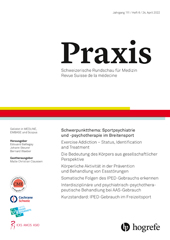Abstract
Zusammenfassung. In der klinischen Praxis sind Patient_innen, die stark unzufrieden mit der Beschaffenheit oder dem Aussehen ihres Körpers sind, häufig. Viele versuchen mittels Körperpraktiken, ihren Körper entsprechend den eigenen Idealvorstellungen zu formen. Dabei geht es aber um weit mehr als um blosses Aussehen. Der Körper ist ein zentrales Element der menschlichen Identität. Das Verhältnis, das wir zu unserem Körper haben ist sozial geprägt und widerspiegelt die Fragen danach, wer wir sind und wie wir wahrgenommen werden möchten. Die Bedürfnisse nach Bindung und Kontrolle stellen hierbei zentrale Motive dar: Beim Bindungsbedürfnis dient die Körperpraxis primär der sozialen Anerkennung, sei es, um positiv oder nicht negativ aufzufallen. Beim Kontrollbedürfnis dient der Körper als fügbares Objekt der Selbstermächtigung.
Abstract. In clinical practice, patients who are strongly dissatisfied with the condition or appearance of their body are common. Many of them try to shape their body according to their own ideals by means of body practices. However, this is about much more than mere appearance. The body is a central element of one’s identity. The relationship we have with our body is socially shaped and reflects questions about who we are and how we want to be perceived. The needs for attachment and control represent central motives here: In the need for attachment, body practice primarily serves social recognition, whether to stand out positively or not negatively. In the case of the need for control, the body serves as a docile object of self-empowerment.
Résumé. Dans la pratique clinique, il est fréquent que les patients soient très insatisfaits de la texture ou de l’apparence de leur corps. Nombreux sont ceux qui essaient de modeler leur corps en fonction de leur propre idéal par le biais de pratiques corporelles. Mais il s’agit là de bien plus que de la simple apparence. Le corps est un élément central de l’identité humaine. Le rapport que nous entretenons avec notre corps est socialement marqué et reflète les questions relatives à ce qui nous sommes et à la manière dont nous souhaitons être perçus. Les besoins d’attachement et de contrôle constituent ici des motifs centraux: Dans le cas du besoin d’attachement, la pratique corporelle sert en premier lieu à la reconnaissance sociale, que ce soit pour se faire remarquer de manière positive ou non négative. Dans le cas du besoin de contrôle, le corps sert d’objet docile à l’autonomisation.
Bibliografie
. Der Körper als kulturelle Inszenierung und Statussymbol. Bundeszentrale für politische Bildung. Aus Politik und Zeitgeschichte : 2007 (18).
(Hrsg.). Leib, Körper und Identität. Berlin: Springer: 2002.
.
Entwicklung des Körperselbst . In: Küchenhoff J Agarwalla P , editors. Körperbild und Persönlichkeit. Berlin: Springer: 2013;11–32.. Körpersoziologie. Stuttgart: utb: 2021.
.
Die Sakralisierung des Profanen. Der Körperkult als individualisierte Sozialform des Religiösen . In: Gugutzer R Böttcher M (Hrsg.). Körper, Sport und Religion . Wiesbaden; Springer: 2012;285–309.. Die feinen Unterschiede: Kritik der gesellschaftlichen Urteilskraft. 3., durchges. Aufl. Frankfurt: Suhrkamp: 1984.
. Sich schön machen: Zur Soziologie von Geschlecht und Schönheitshandeln. Wiesbaden: VS Verlag für Sozialwissenschaften: 2004.
. Projekt Körper: Wie der Kult um die Schönheit unser Leben prägt. Frankfurt am Main; Campus: 2009.
. Körperbildtherapie bei Anorexia und Bulimia nervosa: Ein kognitiv-verhaltenstherapeutisches Behandlungsprogramm. 3., vollständig überarb. Auflage. Göttingen: Hogrefe: 2018.
.
Sozialpsychologie des Körpers . In: Decker O (Hrsg.). Sozialpsychologie und Sozialtheorie. Wiesbaden; Springer F: 2018;27–39.. Neuropsychotherapie. Göttingen; Hogrefe: 2004. https://elibrary.hogrefe.com/book/99.110005/9783840918049.



